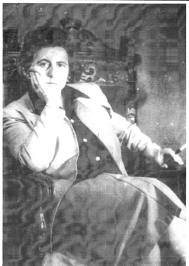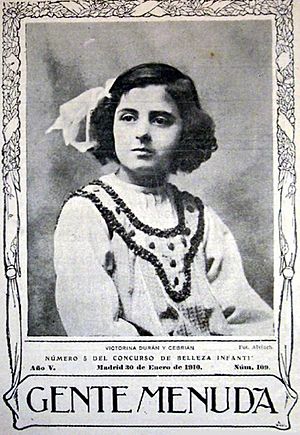Victorina Durán facts for kids
Quick facts for kids
Victorina Durán
|
|
|---|---|
 |
|
| Born |
Victorina Durán Cebrián
11 December 1899 Madrid, Spain
|
| Died | 10 December 1993 (aged 93) Madrid, Spain
|
| Alma mater | Real Academia de Bellas Artes de San Fernando |
| Occupation | Artist, set designer, costume designer |
Victorina Durán Cebrián (born December 11, 1899 – died December 10, 1993) was a talented Spanish artist. She was known for designing sets and costumes for plays and movies. Victorina was also a teacher of costume and set design at a famous school. She was part of the avant-garde art movement, especially Surrealism, in the 1920s and 1930s. Later, she moved to Argentina and became the director of the Teatro Colón, a very important theater in Buenos Aires.
Biography
Early Life and Education
Victorina Durán was born on December 11, 1899, in Madrid, Spain. Her family was well-off and enjoyed culture, even owning a special season ticket for the Teatro Real (Royal Theater). Her mother was a dancer at that theater, and her father was a soldier.
Victorina wanted to be an actress, but her family did not approve. So, she decided to study drawing and painting instead. This led her to meet other famous artists like Salvador Dalí, Remedios Varo, Maruja Mallo, and Rosa Chacel.
She studied at the Real Academia de Bellas Artes de San Fernando in Madrid from 1917 to 1926. In 1929, she achieved something amazing: she won the position of Chair of Costumes and Scenographic Art. This made her the first woman in Spain to get such an important teaching role.
Artistic Work and Innovations
Before becoming a teacher, Victorina was known for her batik art. Batik is a method of dyeing fabrics using wax. She even represented Spain at a big art exhibition in Paris in 1925.
A year later, she joined a group of smart women and artists. They were brought together by Maria de Maeztu to create the Lyceum Club. This club was a place for women to share ideas and support each other.
Victorina also worked with Rivas Cherif to start the Theater School of Art (TEA) in Madrid. She designed costumes and sets for famous theater companies, including those of Margarita Xirgu, Federico García Lorca, and Irene López Heredia. She also created sets for movies, like Blood Wedding.
In the 1930s, Victorina changed how sets and costumes were designed in Spain. She moved away from old styles and mixed modern art with traditional Spanish customs. She wrote about her new ideas in articles for newspapers like La Voz and La Libertad. These articles were called Scenography and Costumes.
Life in Exile and Return
When the Spanish Civil War started in 1937, Victorina left Spain. She went with Margarita Xirgu to Argentina. In Argentina, she became the artistic director for two important theaters: the Colón and Cervantes.
She also helped create new art groups, like La Cuarta Carabela and the Spanish Association of Seven Arts. She worked as a costume designer with the dancer Mercedes Quintana. As a painter, her art was shown in many countries, including Uruguay, Brazil, Chile, Germany, and France.
In 1949, Victorina returned to Europe for a special project. She worked with Salvador Dalí on a play called Don Juan Tenorio in Spain. After that, she often traveled between Europe (especially Paris and Madrid) and Argentina. In the 1980s, she finally settled back in Madrid.
Victorina Durán passed away in Madrid at the age of 93. Her life and work have been studied by many, including Eva María Moreno Lago, who wrote a doctoral thesis about her in 2018.
See also
 In Spanish: Victorina Durán para niños
In Spanish: Victorina Durán para niños


